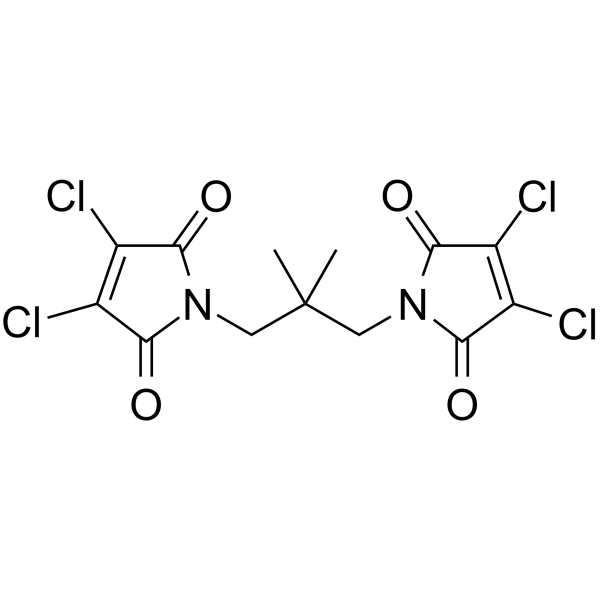Physicochemical Properties
| Molecular Formula | C13H10CL4N2O4 |
| Molecular Weight | 400.04 |
| Exact Mass | 397.939 |
| Elemental Analysis | C, 39.03; H, 2.52; Cl, 35.45; N, 7.00; O, 16.00 |
| CAS # | 203115-63-3 |
| PubChem CID | 357621 |
| Appearance | Light yellow to brown solid powder |
| LogP | 2.004 |
| Hydrogen Bond Donor Count | 0 |
| Hydrogen Bond Acceptor Count | 4 |
| Rotatable Bond Count | 4 |
| Heavy Atom Count | 23 |
| Complexity | 605 |
| Defined Atom Stereocenter Count | 0 |
| SMILES | ClC1=C(C(N(C1=O)CC(C)(C)CN1C(C(=C(C1=O)Cl)Cl)=O)=O)Cl |
| InChi Key | PCOXPBOKDABARQ-UHFFFAOYSA-N |
| InChi Code | InChI=1S/C13H10Cl4N2O4/c1-13(2,3-18-9(20)5(14)6(15)10(18)21)4-19-11(22)7(16)8(17)12(19)23/h3-4H2,1-2H3 |
| Chemical Name | 3,4-dichloro-1-[3-(3,4-dichloro-2,5-dioxopyrrol-1-yl)-2,2-dimethylpropyl]pyrrole-2,5-dione |
| Synonyms | NSC 617145; NSC-617145; NSC617145 |
| HS Tariff Code | 2934.99.9001 |
| Storage |
Powder-20°C 3 years 4°C 2 years In solvent -80°C 6 months -20°C 1 month |
| Shipping Condition | Room temperature (This product is stable at ambient temperature for a few days during ordinary shipping and time spent in Customs) |
Biological Activity
| ln Vitro | In HeLa cells, NSC 617145 (0.75-3 μM; 24-72 hours) exhibits WRN-specific maximum suppression of growth (98%) at the lowest concentration[1]. Protease-induced WRN binding to chromatin and proteasomal breakdown is induced by NSC 617145 (0.75 μM; 6 hours)[1]. NSC 617145 (0.125 μM) functions in concert with extremely low concentrations of Mitomycin C in FA-D2-/-cells to suppress proliferation in a way that is dependent on WRN and to cause chromosomal aberrations and double-strand breaks (DSB). In mitomycin C-treated FA-deficient cells exposed to NSC 617145, there is an increased build-up of Rad51 foci and DNA-PKcs pS2056 foci. This suggests that WRN helicase inhibition inhibits the processing of Rad51-mediated recombination products and triggers NHEJ[1]. Adult T-cell leukemia cells transformed by the human T-cell leukemia virus type 1 (HTLV-1) undergo cell cycle arrest and death when exposed to NSC 617145[2]. |
| Cell Assay |
Cell Viability Assay[1] Cell Types: HeLa cells Tested Concentrations: 0.75 μM, 1 μM, 1.5 μM, 2 μM, 3 μM Incubation Duration: 24 hrs (hours), 48 hrs (hours), 72 hrs (hours) Experimental Results: Inhibited cell proliferation in a WRN-specific manner. Western Blot Analysis[1] Cell Types: HeLa cells Tested Concentrations: 0.75 μM Incubation Duration: 6 hrs (hours) Experimental Results: Caused WRN to become degraded by a proteasome-mediated pathway. |
| References |
[1]. Werner syndrome helicase has a critical role in DNA damage responses in the absence of a functional fanconi anemia pathway. Cancer Res. 2013 Sep 1;73(17):5497-507. [2]. WRN-targeted therapy using inhibitors NSC 19630 and NSC 617145 induce apoptosis in HTLV-1-transformed adult T-cell leukemia cells. J Hematol Oncol. 2016 Nov 9;9(1):121. |
Solubility Data
| Solubility (In Vitro) | DMSO : ~10 mg/mL (~25 mM) |
| Solubility (In Vivo) |
Solubility in Formulation 1: ≥ 1.67 mg/mL (4.17 mM) (saturation unknown) in 10% DMSO + 90% Corn Oil (add these co-solvents sequentially from left to right, and one by one), clear solution. For example, if 1 mL of working solution is to be prepared, you can add 100 μL of 16.7 mg/mL clear DMSO stock solution to 900 μL of corn oil and mix evenly. (Please use freshly prepared in vivo formulations for optimal results.) |
| Preparing Stock Solutions | 1 mg | 5 mg | 10 mg | |
| 1 mM | 2.4998 mL | 12.4988 mL | 24.9975 mL | |
| 5 mM | 0.5000 mL | 2.4998 mL | 4.9995 mL | |
| 10 mM | 0.2500 mL | 1.2499 mL | 2.4998 mL |
